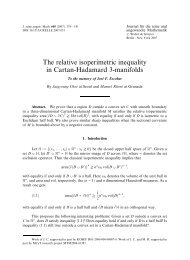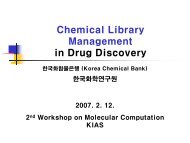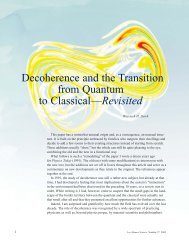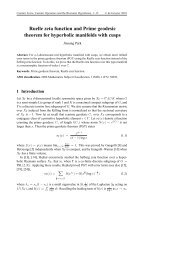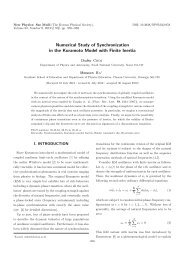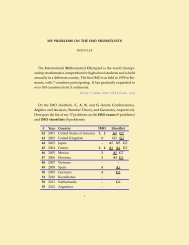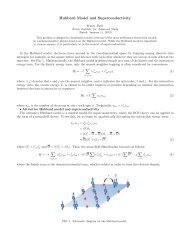A Quantum Kirwan Map: Bubbling and Fredholm Theory for ... - KIAS
A Quantum Kirwan Map: Bubbling and Fredholm Theory for ... - KIAS
A Quantum Kirwan Map: Bubbling and Fredholm Theory for ... - KIAS
You also want an ePaper? Increase the reach of your titles
YUMPU automatically turns print PDFs into web optimized ePapers that Google loves.
6 1. MOTIVATION AND MAIN RESULTS1.3. <strong>Bubbling</strong> <strong>for</strong> vortices over the planeTo explain the first main result of this memoir, we assume that (M,ω) isaspherical, i.e., condition (1.6) is satisfied. 21 We denote by(1.15) ˜M :={(P,A,u) ∈ ˜BC∣ ∣ (1.8,1.9)}, M := ˜M/∼the class of all vortices over C <strong>and</strong> the set of equivalence classes of such vortices. Thelatter is equipped with a natural topology. 22 Consider the subspace of all classesin M with fixed finite energy E > 0. There are three sources of non-compactnessof this space: Consider a sequence W ν ∈ M, ν ∈ N, of classes of energy E. In thelimit ν → ∞, the following scenarios (<strong>and</strong> combinations) may occur:Case 1. The energy density of W ν blows up at some point in C.Case 2. There exists a number r > 0 <strong>and</strong> a sequence of points z ν ∈ C that convergesto ∞, such that the energy density of W ν on the ball B r (z ν ) is boundedabove <strong>and</strong> below by some fixed positive constants.Case 3. The energy densities converge to 0, i.e., the energy is spread out more <strong>and</strong>more.In case 1, by rescaling W ν around the bubbling point, in the limit ν → ∞,we obtain a non-constant J-holomorphic map from C to M. Using removal ofsingularity, this is excluded by the asphericity condition. In case 2, we pull W νback by the translation z ↦→ z + z ν , <strong>and</strong> in the limit ν → ∞, obtain a vortex classover C. Finally, in case 3, we “zoom out” more <strong>and</strong> more. In the limit ν → ∞ <strong>and</strong>after removing the singularity at ∞, we obtain a pseudo-holomorphic map from S 2to the symplectic quotient M = µ −1 (0)/G.Hence in the limit, passing to a subsequence, we expect W ν to converge to a newsort of stable map, which consists of vortex classes over C <strong>and</strong> pseudo-holomorphicspheres in M. Here an important difference to Gromov-convergence <strong>for</strong> pseudoholomorphicmaps is the following: Although the vortex equations are invariantunder all orientation preserving isometries of Σ, only translations on C should beallowed as reparametrizations used to obtain a vortex class over C in the limit.Hence we should disregard some symmetries of the equations. The reasons are thatotherwise the reparametrization group does not always act with finite isotropy onthe set of simple stable maps, <strong>and</strong> that there is no suitable evaluation map on theset of vortex classes, which is invariant under rotation. 23We are now ready to <strong>for</strong>mulate the first main result. Here we say that (M,ω,µ,J)is convex at ∞ iff there exists a proper G-invariant function f ∈ C ∞ (M,[0, ∞))<strong>and</strong> a constant C ∈ [0, ∞), such thatω(∇ v ∇f(x),Jv) − ω(∇ Jv ∇f(x),v) ≥ 0, df(x)JL x µ(x) ≥ 0,<strong>for</strong> every x ∈ f −1 ([C, ∞)) <strong>and</strong> 0 ≠ v ∈ T x M. Here ∇ denotes the Levi-Civitaconnection of the metric ω(·,J·). This condition reduces to the existence of a21 The general situation is discussed in Remark 17 in Section 2.1.22 It is induced by the C ∞ -topology on compact subsets of C.23 See Remarks 22 <strong>and</strong> 33 in Sections 2.2 <strong>and</strong> 2.4.



